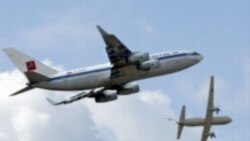But Aleksandr Neradko, the head of the federal service for transport supervision, was firm. He told journalists yesterday the plane will not fly until faults found in its braking system are repaired.
“Il 96-300 planes will not fly from now on until the mentioned defects are removed. This decision was influenced by a systematical shortcoming -- the lack of effort to remove the mentioned failures and disrepairs, which companies using this type of aircraft had already long been pointing out,” Neradko said.
In August alone, several incidents have been reported during which Il-96’s brakes did not function properly.
Yesterday’s decision is also likely to be connected to another recent incident -- one involving the Russian president. During a visit to Finland earlier this month, Putin had to switch to a back-up jet due to an unspecified mechanical malfunction in his Il-96.
For Aeroflot, Russia’s flagship airline, the move could bear severe financial consequences. The company owns six of the 13 Il-96 planes currently in use, and these service as much as 40 percent of its long-haul routes.
Aeroflot Deputy General Director Lev Koshlyakov told reporters the airline stands to lose $20 million if the grounding lasts through the end of October.
The sudden announcement of the aircraft’s grounding yesterday also meant Aeroflot had to scramble to reorganize its flight schedule.
Koshlyakov said the decision will create inconveniences for passengers around the world.
“This affects our whole long-distance network, since to cover flights to [Russia’s] Far East and to Southeast Asia, we need to redirect Boeing 767s flying from other destinations and cut flights to the United States, among others,” Koshlyakov said.
Aeroflot has temporarily cancelled all flights to Hanoi and some flights to Washington, Toronto, Beijing, and Seoul.
The other seven Il-96s currently in use are owned by local Russian airlines.
It is still unclear how long the planes will be grounded, but Aeroflot says it is hoping to resume flights using this aircraft as soon as the repairs are completed.
Aleksandr Velovich is a Moscow-based aviation consultant and a former engineer at the Mikoyan design bureau.
He told RFE/RL there is no reason to ban Il-96s from the sky after the repairs.
“Of course, there is no need to ground the Ilyushin-96 forever. It is a perfectly modern aircraft that meets Western standards. The Russian airlines’ fleets definitely need to be renewed, but this does not affect the Ilyushin-96. There are hundreds of older aircraft that are nearing the end of their term of use,” Velovich said.
Ninety-five percent of Russia’s air fleet consists of aircraft assembled during the Soviet era. And with the Ilyushin 96-300, Russia is hoping to compete with foreign aircraft manufacturers in renewing Russia’s ageing air fleet.
The large passenger jet is one of Russia’s most up-to-date aircraft and one of the few that meets European noise level standards. It can carry up to 300 passengers and is used for long-distance flights.
Russia clinched several deals involving the Ilyushin 96-300 during its MAKS international air show this month. These include a $100 million agreement to sell the aircraft to Cuba.
